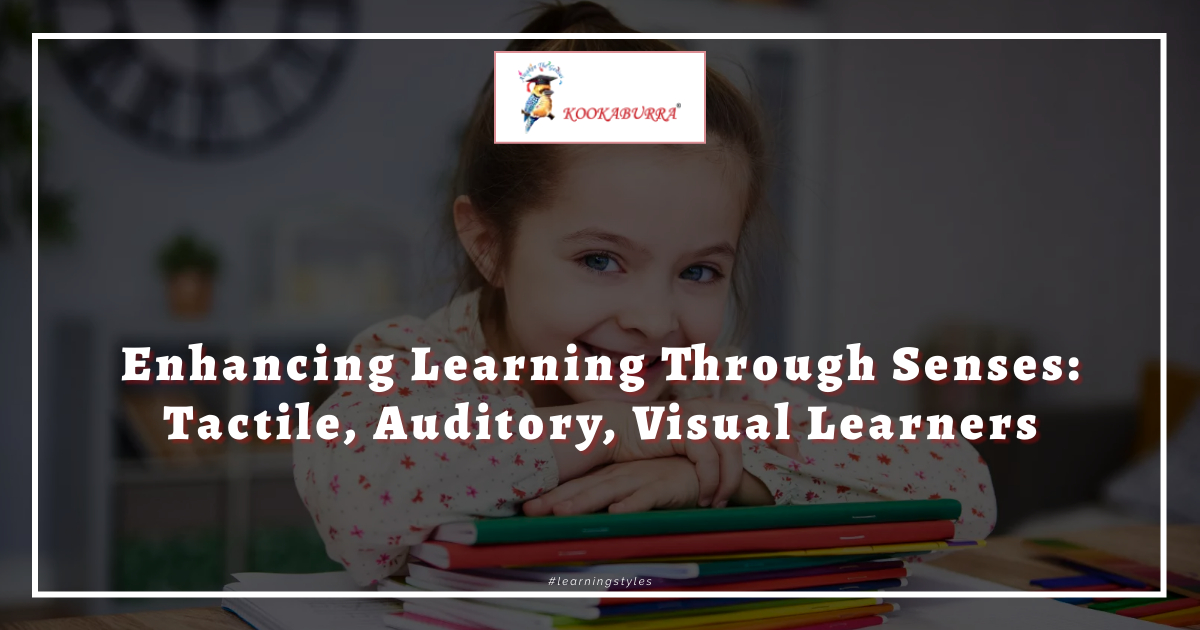
ENHANCING LEARNING THROUGH SENSES: TACTILE, AUDITORY, VISUAL LEARNERS
In the vibrant world of early childhood education, acknowledging and catering to diverse learning styles is essential to fostering a supportive and inclusive learning environment. Every child possesses unique strengths and preferences when it comes to absorbing new information. By recognising and embracing these vital differences, educators and parents can create tailored learning experiences that enable children to thrive.
Let’s delve into 3 essential learning styles practised at Kookaburra: tactile (sense of touch), auditory (hearing) and visual (sense of sight):
1. Tactile Learners (Touch):
Tactile learners, often known to be kinesthetic learners, absorb information best through physical interaction and hands-on experiences. These children learn by touching and manipulating objects. It is recommended to allow them to engage with the world in a tangible way. Tactile learners are highly kinesthetic, meaning they rely on movement and touch to comprehend concepts fully.
Preschool integration: Preschoolers can support tactile learners by incorporating interactive activities into their daily activities. Activities or toys such as sensory play, building with blocks, and engaging in arts and crafts can capture their interests and additionally enhance their understanding of various concepts. Tactile learners benefit significantly from educational games that involve touch and movement, as these experiences help them grasp abstract ideas more effectively.
2. Auditory Learners (Hear):
Auditory learners are individuals who process information best through listening. They have a keen sense of hearing and excel at absorbing knowledge through spoken words, sounds, and rhythms. These learners thrive in environments where they can actively listen, whether it’s a story being read aloud or a classroom open conversation.
Preschool integration: To cater to auditory learners, kindergarteners can incorporate storytelling, discussions, and interactive conversations into their teaching methods. Utilizing audio resources, such as audiobooks and educational podcasts, can also captivate their attention and enhance their understanding of various topics. Encouraging auditory learners to participate in group discussions and presentations allows them to express their thoughts verbally, reinforcing their learning experience.
3. Visual Learners (See):
Visual learners process information most effectively through visual cues like images, diagrams, and videos. They rely on seeing and observing to understand complex ideas and concepts. Visual learners are often skilled at recognizing patterns, colours, and spatial relationships.
Preschool Integration: Educators can support visual learners by using visual aids, charts, and graphs to illustrate concepts visually. Interactive whiteboards, educational videos, and multimedia presentations can capture their interest and enhance their comprehension. Encouraging visual learners to create mind maps, diagrams, and drawings related to the topics being taught can help them organize information and reinforce their understanding.
The Distinguished Kookaburra Way:
It is vital and ideal to recognize and accommodate diverse learning styles in your teaching environment be it a kindergarten classroom or a higher educational institute. Every educator needs to seamlessly blend all 3 kinds of learning styles to ensure all 3 learners are satisfied. Moreover, it will foster a positive and enriching educational experience. By tailoring teaching methods to cater to tactile, auditory, and visual learners, educators can create a learning environment where every child feels valued and understood.
At Kookaburra, the best early childhood education Preschool in Mumbai, we embrace these differences and enhance academic performance by nurturing a lifelong love for learning in every child, setting the foundation for a bright and successful future.
